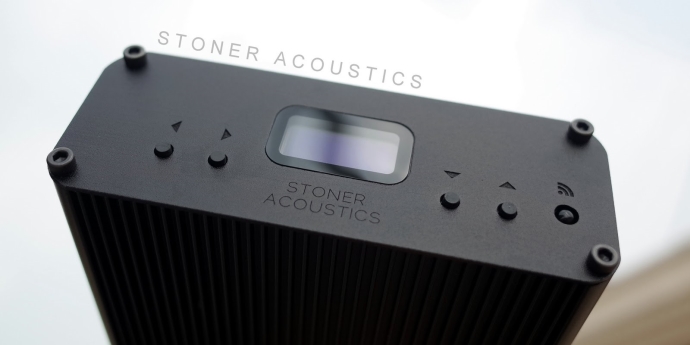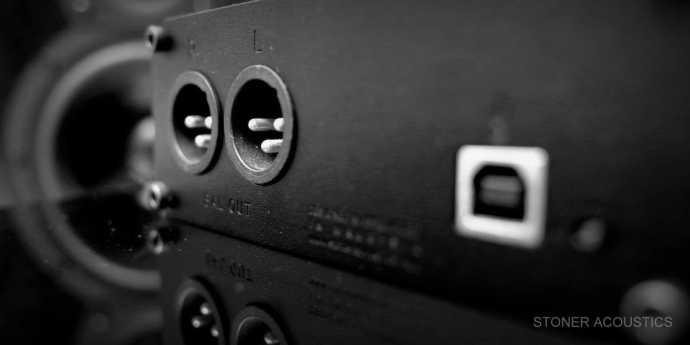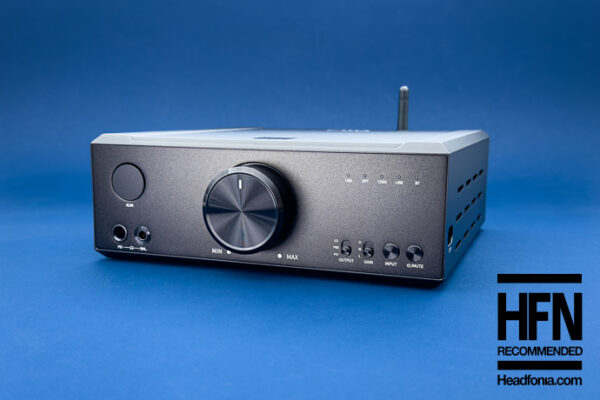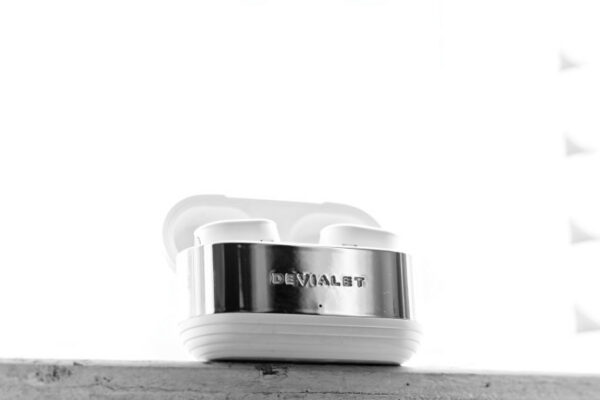EGA OVERVIEW
- 7VA 230/115V Toroidal Transformer
- Fully Differential Amplification
- ALPS Quad RK27114A
- Input Buffers – LME49990
- Differential Amplifiers – OPA1632
- Output Drivers – LME49610
- 183mm (L) x 120mm (W) x 45mm (H) not including knob. Weight: ±1kg
SPECIFICATIONS
- Gain (Av) = +10dB
- Output Impedance = 0.1ohm ± 10%
- Input Impedance = 10kohm
- Peak output amplitude : 12Vrms
- Peak output power : 1watt
- THD+N : 0.0005% @ 1khz
INTERFACE
- Input:
- 115/230Vac Switch
- Standard IEC AC Input
- 2 x Female XLR-3P Input (Left and Right)
- Quad Logarithmic Analog Volume Control
- Output:
- 2 x Female XLR-3P Headphone Output
- 1 x Female XLR-4P Headphone Output
End Game DAC – EGD
The EGD looks and feels identical to the EGA and stacking them after you’ve stuck on some removable feet is the thing to do. The DAC with the OLED screen in the middle is the unit that draws all the attention. I ended up putting the DAC on top of the EGA as it just looks a little better (yes it matters).
To get the EGD working on a Windows PC (USB2.0) you’ll need to install the Bravo driver. Installation is extremely easy and setting up the EGD in Foobar2000 with the correct ASIO-settings can be done by almost anybody. In case you absolutely have no clue what you’re supposed to do, Stoner made a manual available for download on their website. Once you’ve got it all set up, your EGD will display the correct bit and sample rate it is receiving as ASIO does the bitperfect delivery. When quickly switching between different quality files however the EGD sometimes will hang up on you. Clicking the file again will get the song started though. The ESS Sabre9018AQ2M DAC chip supports up to PCM 32bits/384kHz (ASIO) and also has DSD native support up to DSD256 & DoP up to DSD128. The EGD only has a USB input, nothing else.
Stoner Acoustics made the EGD to use with balanced amplifiers only. Sure you can always use an adapter to go from balanced to RCA should you only have an amp with unbalanced inputs but that’s not what was intended. “Isolation” is what the EGD is developed around. At the same time the EGD’s menu and its settings are very elaborated (see below). Except for the slow roll off and the End Game Mode, I’ve always kept all the default settings as recommended by Stoner.

By utilizing isolation from the start to the end, we separate transmission issues caused by non-isolated computer powered from the USB yet maintaining full consistency across all platforms. The EGD is absolutely articulate and compact in its design that not only it is able to function purely via USB power, it is also able to provide an array of unique features found only in expensive high end devices.
EGD OVERVIEW
- USB POWERED
- Fully Differential (Balanced) Output
- High Performance ESS Sabre9018AQ2M
- Dedicated Ultra Low Noise LDO for all stages
- Fully Isolated Analog Stages
- Ultra Low Phase Noise CCHD-575
- OLED Display
- 183mm(D) x 120mm(W) x 45mm(H). Weight ±1Kg
SPECIFICATIONS
- ASIO supported up to PCM 32bits/384kHz
- DSD native support up to DSD256 & DoP up to DSD128
- 4.6 Vrms @ 0dBFS @ 100ohms Zout (Balanced)
- Power Consumption = 5V @ 350mA ± A10%
- THD+N > 0.0007% @ 1khz (A-weighted)
- Supports Windows (Drivers required), Mac and Ubuntu
INTERFACE
- Input:
- Gold plated USB-B Input
- UAC 1.0/2.0 Mode Toggle
- 4 x Push Buttons (Directional)
- Apple Remote Supported*
- Output:
- 2 x XLR-3P Male Differential Line Output
- OLED Display
- Software Features:
- Volume Level @ 0.5 dB/step (-127.5dB to 0dB)
- Selectable FIR and IIR Filters
- Selectable I2S DPLL, DSD DPLL Bandwidth
- De-emphasis support from 32kHz to 48kHz
- Left and Right Balance Adjustment up to +/- 15 dB
- Left and Right Channel Inversion
- End Game Mode (THD Compensation)
Stoner Acoustics EGD and EGA SOUND on the next Page, after the click








Barun C
Nice article, Lieven couple of questions, could you elaborate on the part of
“The HE-560 with this setup has very good layering” and “The overall sound signature is musical but neutral”.
It says “sticok” in the beginning of the fourth line of the End Words segment, I believe it will be “stock”.
Thanks
Headfonia_L.
Hi Barun, in what way would you like me to elaborate on that?
Thanks for pointing out the typo, weird my software didn’t notice that one.
Barun C
Well I get confused when the word “layering” comes up, cause I don’t get the context e.g. when playing keyboard I can mix 4-5 layers of sound and when I’m playing, the number of layers coming out when sound is created depends upon how hard I hit the keys, I get what layering of the sound means there but for headphones is it instrument separation or layering of harmonic environment around which melody and rhythm of a song is crafted?
And in case of the other “musical but neutral” , what does musical mean in comparison to neutral here, do you mean that it is neutral but it doesn’t get in the way of enjoying your music?
Thanks
Headfonia_L.
How to explain. Imagine bass: no layered bass would go BRRROOOOM and layered bass would go BbBrRrRrROoOoOoMmMmM. Same goes for voices, guitars, etc. Layering of the tone with specific detail and difference, not just one same tone. I hope I make sense to you. It’s not instrumental separation to me. The better the amp, the better the layering should be, like horizontal layers of sound/detail. Confusing? 😀
There are several types of neutral (flat, not boosting any FREQ): boring, musical, analytic, …. Some amps just suck all the fun out of it, some are very analytic and other manage to keep it neutral (as in flat) but in a musical, enjoyable way. Those are the amps or DACs you want.
Mental note, I should reply when I’m more awake and after coffee
Barun C
Thanks Lieven. Neutral is very hard to define, and I sort of get what you mean here. Measurements and listening experience always don’t go hand in hand and in case of neutral it is also quite similar.
So when I read your example I get, that by layering you mean attack, sustain and decay of sound. Cause that is what I can infer from you example.
Headfonia_L.
I’ll see if I can find an example this weekend, would be easier to show. But then you would still need both a layered and non layered amp. I’m not talking about attack and decay :/
Patrick Murray
Hey do You feel the EGA for 300$ is considered a good buy? The DAC has and is still out of stock which is really too bad, but was just wondering about the Amp for 300$ do you think there are other amps out there that are better options? like the jotunheim from Schiit
Mubin L
Stoner audio is doing a clearance sale. EGA for RM450(125usd). Should I get?
Though I don’t have a fully balanced DAC and pretty much only own mid end headphones. (HD6XX, MS2(nhoord redv2), modded T50rp mk3).